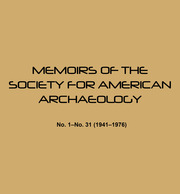Article contents
Pariñas-Chira Archaeology: A Preliminary Report
Published online by Cambridge University Press: 27 June 2018
Extract
The following account of ancient remains in northern Peru is the result of a reconnaissance during May, 1941 from Cabo Blanco southward to Piura. The surface collections from various archaeological sites, now in the Peabody Museum of Harvard University, have not yet been repaired and will be published subsequently. The present report, however, includes material from local collections, which tells the basic story.
The region of which we write embraces two river valleys: Parinas and Chira (Fig. 44). The Parinas, according to a classification published by Kroeber, is a third-class river which reaches the sea a few miles north of the oil port of Talara. When I saw it, there was considerable flow of water, but automobiles could cross in places.
- Type
- Northern Peru
- Information
- Memoirs of the Society for American Archaeology , Volume 4: A Reappraisal of Peruvian Archaeology , 1948 , pp. 53 - 65
- Copyright
- Copyright © Society for American Archaeology 1945
References
1 Kroeber, 1930, p. 74.
2 I am indebted to Captain Alfred Adler for arranging my transportation from Lima and to Mr. R. H. Ebbets of the International Petroleum Co. for his hospitality in Talara and for the use of a car.
3 Kroeber, 1930, Pl. XIV.
4 This type of cotton was grown all over Peru in aboriginal times. It has been largely replaced by Tanguis.
5 December flow of 1916 not included.
6 Besides water used by the city of Lima.
7 Garcilaso de la Vega, 1609, Vol. 9, Chap. 2.
8 This name is spelled Puchiu (Garcilaso), Pohechos (Pedro Pizarro), and in various manners. Herrera (Dec. IV, Lib. IX, Cap. III) writes of “Poechos, which some call Mayabilca.” Raymondi also gives Poechos. The current map published by the Peruvian government has Poeches.
9 Xéres, 1872, p. 20.
10 Llamas and alpacas.
11 Pedro Pizarro, 1921, Vol. 1, p. 166.
12 Means (in Pedro Pizarro, 1921, Vol. 2, p. 51) identifies Lachira as the Hacienda Sojo. This is improbable as Raimondi (1874-1913, Vol. 2, p. 20) states that it is “á pocas cuadras” from la Huaca. Sojo is 35 kilometers to the east.
13 For a full account of these changes, see Pedro Pizarro, 1921, Vol. 2, p. 511, Note 62.
14 Pedro Pizarro, 1921, Vol. 1, p. 170.
15 Cieza de León, 1864, p. 213.
16 Anonymous, 1885.
17 Spruce, 1864.
18 Cieza de León, 1864, Introduction, pp. xlii-xlv, Fns.
19 Means, 1931, p. 114, Fn. 12; 1918, p. 343.
20 Alcedo, 1812-15, Vol. 4, p. 414.
21 Hervas, 1800-05, Vol. 1, Cap. 4; Brinton, 1891, pp. 224-6; Viñaza, 1892; Mitre, 1909-12.
22 Prince, 1905, p. 50; Means, 1931, p. 114, Fn. 12; Rivet, 1924, p. 678 and map.
23 I am indebted to Mr. and Mrs. D. L. Frizzell and Mrs. L. H. Fraser for their hospitality and for taking me to local archaeological sites.
24 See Nordenskiold, 1924, pp. 126,134, Map 14; Lothrop, 1932, pp. 143-4, 173-4.
25 Kroeber and Muelle, 1942.
26 I am indebted to Mr. and Mrs. D. L. Frizzell, Messrs. H. F. Brewen, and V. J. Moroney for permission to inspect their collections from Málaca. Dr. George A. Paulson kindly presented the Museum with the specimen illustrated in Figure 50.
27 Kroeber, 1944, Appendix F, PL 41, A.
28 Pedro Pizzaro, 1921, Vol. 1, p. 150.
29 Rowe, 1942.
30 I am indebted to Victor Checa for an invitation to stay at the hacienda, to Senora Victoria Eguiguren de Checa for kindly hospitality, and to Enrique Checa for driving me around the countryside and to Piura.
31 Xéres, 1872, p. 25.
32 Kroeber, 1925, Pl. 69, K, L.
33 Larco Hoyle, 1941, Figs. 14, 27, etc.
34 Means, 1931, Fig. 79.
35 Kroeber and Muelle, 1942.
36 Bennett, 1939.
37 Kroeber, 1925, Pis. 61, L and 69, N; Bennett, 1939, Fig. 4, B, E, H.
38 Griffin and Krieger, 1947.
39 Bennett, 1939, p. SO.
40 Compare our Figure 54, D, with Putman, 1914, Pl. XXIII: 14. This is an almost identical vessel from Chiclayo with a monkey on the spout.
- 1
- Cited by


